Don't wanna be here? Send us removal request.
Text
WEEK 10 PRESENTATION
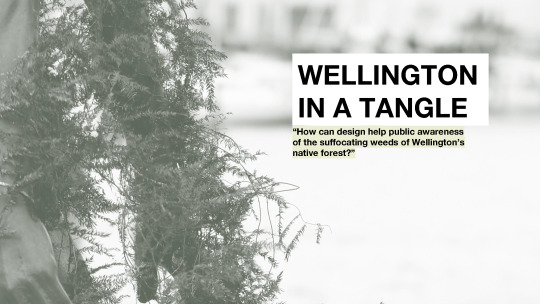


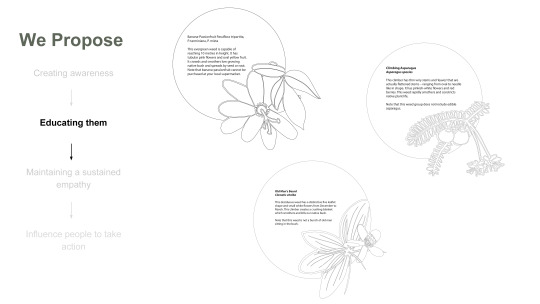
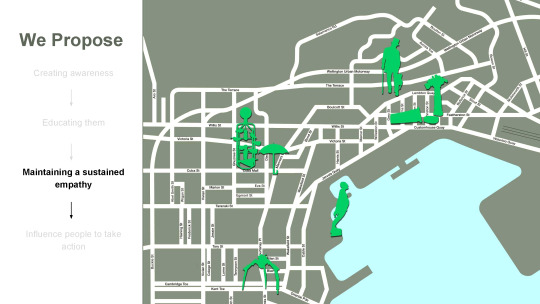


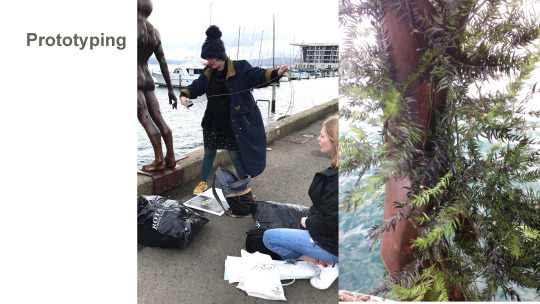
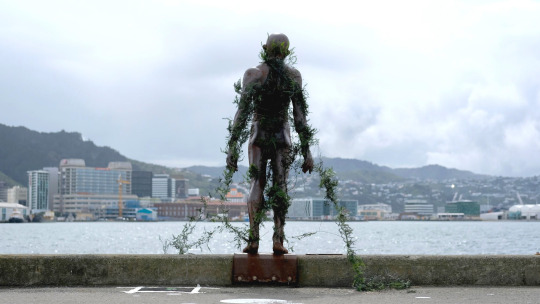
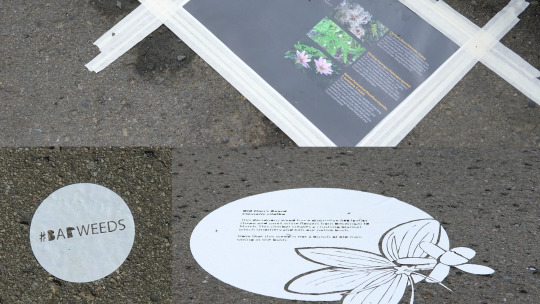

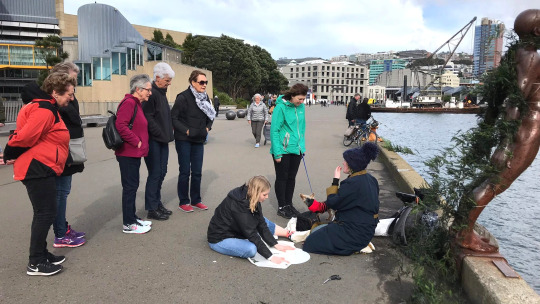
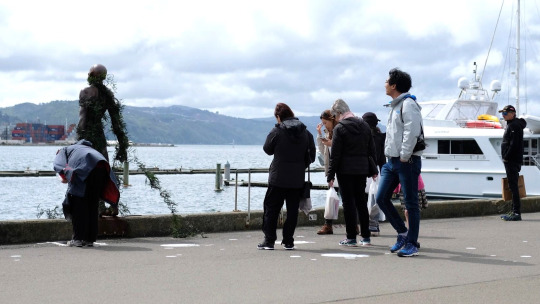

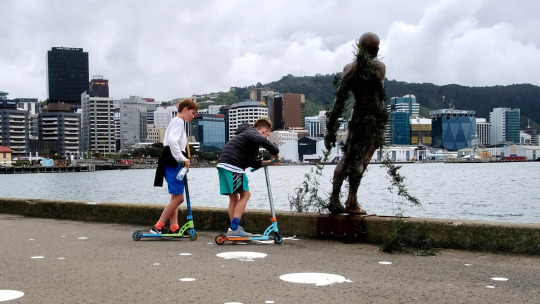

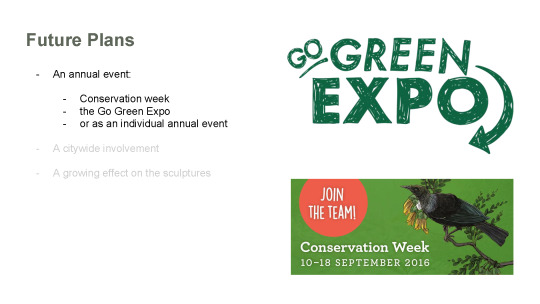

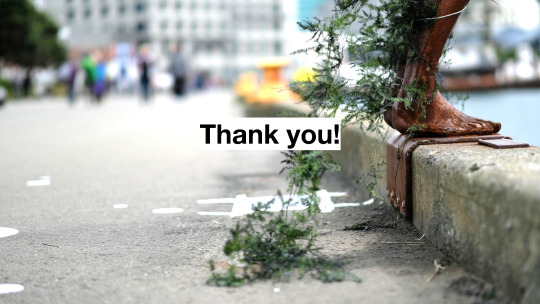
Maddy
Ting
SLIDE 1
Hi there, I’m Maddy and this is Ting. Our design initiative is called the Wellington in a Tangle, also including Kat and Phoebe; and we have been tasked by you to figure out how design can help raise awareness for the ecological weed problem in Wellington.
We are focusing, as instructed, on the climbing asparagus, old man’s beard and banana passionfruit vine like ecological weeds. They each are extremely harmful to native plant life and we found, in our own work through the production of our prototype, how difficult they are to remove.
SLIDE 2
We propose an annual an awareness campaign. This campaign involves 3 steps; creating awareness, educating the public and maintaining a sustained empathy which would all influence people to take action on behalf of the Wellington City Council.
SLIDE 3
The first step in our awareness campaign begins with an urban intervention. This urban intervention has taken the shape of an installation on the ‘Solace in the Wind’ sculpture on Wellington’s waterfront. As seen in this mock up image here we aim to incorporate the kinetic nature of the sculpture with our installation; wrapping weeds around the body and limbs. This will act as a way to catch the public’s attention and become a conversation starter.
SLIDE 4
With this urban intervention we must also provide the public with some information before they move past. Vinyl stickers are an easy, affordable way to do this. As seen here we designed 3 sticker prototypes with basic images of the weeds and some information that helped to identify them. There were also some catchy taglines at the end of each paragraph to remain in a person’s mind. For example, we provided a note that banana-passionfruit cannot be purchased at your local supermarket; just in case.
SLIDE 5
The next step involves maintaining a sustained level of empathy over a longer period. To achieve this the installation would occur on statues all around Wellington’s city centre on an annual basis, as seen in the map here. We could maintain this renewal of information by connecting these installations to annual events.
SLIDE 6
These three steps working together will provide people the information and initiative to take action themselves.
SLIDE 7
Producing the urban intervention was a process of picking the climbing asparagus from Aro Valley and painting it black to add more depth and contrast to the green weeds.
SLIDE 8
Setting up the installation at the waterfront involved wrapping rope initially around the sculpture to provide support. The asparagus was then wrapped around the ‘Solace in the Wind’ sculpture. Emulating how it would behave in nature. We are grateful that the artist, Max Patte, and the Wellington waterfront coordinator Fraser Ebbett were happy for us to do this.
SLIDE 9
The final prototype created a great initial stopping factor.
SLIDE 10
The stickers and posters provided more information for people who stopped as well as guiding them towards the sculpture. The hashtag BADWEEDS was used to highlight the topic and connect people online.
SLIDE 11
The urban intervention was very successful. Here we have some people interacting with the stickers.
SLIDE 12
Here we have an example of how the older generation has a lot more knowledge about the subject already. They knew exactly what we were talking about as we set up.
SLIDE 13
This image perfectly shows the many layers of interaction with this installation.
SLIDE 14
Here we have some more people looking at the stickers.
SLIDE 15
There were some kids who found the installation interesting. Most kids were there with their parents; who enjoyed starting that dialogue about the ecological weed problem.
SLIDE 16
Many young adults enjoyed the tactile nature of the installation; taking photos and touching it. Making it from the actual weeds proved successful here.
SLIDE 17
The future of this project involves the continued raising of awareness and education over the years. We will do this by connecting this urban intervention to an annual event in Wellington, like Conservation Week or the Go Green Expo.
SLIDE 18
The scope of the urban intervention will also grow as we spread around different sculptures in Wellington’s arty city. Where the weeds would daily increase in volume on the multiple sculptures around the city to produce an effect of vine like growth. We believe this response truly reflects the Wellington City Council’s need for awareness, education and empathy. This action has proven itself to be instantly effective and we are confident that it will provide a lasting impact over the years.
SLIDE 19 - DONE
0 notes
Text
FINAL DOSSIER











Our final dossier reflects the aesthetically pleasing nature of our entire plan. Something cool and accessible; available to the general public. It provides certain pieces of information not given in our presentation i.e. budget.
0 notes
Photo










Interaction
These images prove the engagement they had by people seeing the sculpture and being intrigued by the weeds, moving closer to inspect the sculpture, and then educating themselves by looking at the information found on the ground.
These were just some of the numerous people that looked at our sculpture and prove the success we had in creating awareness for the ecological weed problem in Wellington!
0 notes
Text
Dossier Draft

















All the information and basic format works; but just needs changing to become more cohesive. Slideshow for the final presentation will be formatted to fit with the aesthetic of the final dossier.
0 notes
Text
Informal Presentation Feedback
Feedback from the informal presentation:
There is a double up of information on our slides: Needs a clear structure, set a plan; Intro, Big Picture, Test Run, Results/Response.
Don’t talk about bad results from the prototype, talk only about the good, sell the concept, we are the salesmen for this concept so make it desirable.
Don’t say we did things because they were easiest ( instead say”our first one is”). Don’t say why or have a better reason e.g The other weeds would look better when fruiting. Other weeds could be used for other sculptures.
Reduce the amount of text on the slides, it’s hard to read and listen at the same time, just use mainly all pictures to fill the slide and have only bullet points or a small amount of text if necessary. It looks better for us to just talk because it means we know what we are talking about instead of having to rely on slides for information.
They were impressed by our conclusions about our target audience and agreed with our opinion about it, but the representations of it on the slide should be made much simpler
We got praised for our concept, and major ups for actually going out, producing and testing our prototype for real, this makes our conclusions creditable because we actually have first hand evidence to back it up.
0 notes
Photo






Final Prototype
To grab the attention of the general public and appeal to this hard to target demographic we will bring the urban intervention to them by placing it on various sculptures around Wellington with high amounts of foot traffic.
Walking towards the sculpture we will create 3 stages of engagement.
-First seeing the sculpture covered in weeds; then moving closer towards it to engage their curiosity.
-Second would be; as they approach the sculpture they will notice the vinyl stickers on the ground which gives them instant context for the sculpture.
-Third; they will read the information on the poster/larger stickers and scan a QR code for a Wellington City Council affiliated website.
From our observations of the prototype we have seen that it is very effective in gaining the public’s attention. There was a large amount of interest from a wide demographic. The older generation would show interest in the installation because they were already knowledgeable about the problem and would then discuss it with the younger people with them. The younger demographic would take photos and touch the plants; showing an interest in the tactile nature of the installation.
Budget of prototype
We have proven that this urban intervention can be produced on a low budget but realise the drawbacks of this are the fact that it is not very long-lasting.
The cost of this prototype vs the cost of a more durable one:
Stickers – $11.00
Weeds – free
Spray paint – 5.97 x 4 = $23.88
Poster + lamination = $5.00
Manual Labour – priceless
$39.88 😊
0 notes
Photo







These were the sticker outlines that we then cut out on the vinyl cut. At first we thought they would be successful, but we found when we did our prototype on the man at the waterfront that the Climbing Asparagus and Old man’s Beard stickers were very dainty and didn’t place as well on the concrete as we would of liked. We also placed it when it started to rain so the sticky side of the sticker began to be void.
In the future we would develop more refined shapes that wouldn’t break on us, that weren’t so bitsy and realize it will take longer to excite so we need to be patient with the overall process.
Overall the vinyl stickers were intriguing shapes on the ground and really popped off the concrete which drew people in to the sculpture.
0 notes
Photo



Vinyl Sticker Drawings Developed
We wanted to develop the stickers to look more like the actual weeds so people can easily identify what they are.
They are as follow, Asparagus, Old Man’s Beard and Banana Passionfruit.
0 notes
Photo





Preparation for the test
We went to Aro Valley and found heaps of climbing asparagus. We took them back and paint them black.
0 notes
Text
TEST ON SUNDAY
Getting permission to test our prototype involved emailing multiple people working in and around Wellington City Council.
Initially we emailed Eve Armstrong (the head of public art proposals within WCC) about producing our installation on the bucket fountain. We understood this would be difficult as it involved sticking to health and safety guidelines and setting up scaffolding so as not to damage the fountain. So to combat this we proposed another option for our urban intervention.


Eve then lead me to Fraser Ebbet; the head of waterfront organisation in Wellington. He was extremely helpful and integral to the success of our prototype.









Getting permission from the artist and hearing from Fraser that he was interested and invested in different people adapting his artwork allowed us a freedom to truly transform the ‘Solace in the Wind’.
0 notes
Photo





Painting Process
In preparation for our final product of the weeds on the man at the waterfront, one of our major concerns were how the weeds would cope being out of the ground. So we essentially needed a way to preserve them for a timeframe of around 48 hours to complete our project. This gives us the Saturday to go and collect weeds and the Sunday morning to set up our art installation and have the public interact with it and question what is going on.
Even though these aren’t weeds, we cut some greenery from one of the Uni trees and spray painted the left side with clear acrylic paint and the other side with black paint. After 5 days of spraying painting them, the acrylic “weeds” started to wilt, discolour, peel away and almost curl in on itself. This could be due to a reaction with the paint. Where as the black “weeds” was essentially preserved by the black paint. We discussed it further and we think having black weeds on the man at the waterfront will create a bigger pattern by implying that they are bad and not these beautiful plants that people think they are.
0 notes
Text
What needs to be done?
- expand on why the demographic are difficult to target and why we have overcome this problem
- change the wording in the dossier to better fit the client and brief e.g Parks, Sports and Recreation, rewording of the last paragraph
- change our main goal of the bucket fountain to a sculpture less sensitive (at least for our initial test. We would need to seriously consider health and safety; no one could climb the fountain and there is the potential for damage - also the vinyl stickers could create a slippery surface for the foot path surrounding the bucket fountain - NOT SAFE
- vinyl stickers work as a way of providing information but need to more accurately depict the weeds and not be too wordy with the text. Is there a conflict promoting with vinyl stickers at events where there are people covering the foot path - justify this!
- more detailed versions of the mock ups (larger image in the dossier)
- font too small in the dossier; work on the wording in the stickers
- make sure everything draws back to our target demographic
0 notes
Text
Information for stickers:
We are Massey University students working on a theoretical project for Wellington City Council. There is an ecological weed problem in Wellington, and throughout New Zealand, which we would like everyone to become aware of.
“Many of the weedy species that are invading and damaging our natural areas are ornamental plants that have ‘jumped the fence’ from gardens and gone wild. It costs councils, government departments and private landowners millions of dollars, and volunteers and community groups thousands of unpaid hours, to control these weeds every year.”
There are three ecological weeds that we would like you to remember. Which are Old Man’s Beard, Climbing Asparagus and Banana-Passionfruit. Don’t be fooled by their funny names they are all climbers/vines that are difficult to permanently eradicate and deadly to the native bush of the Wellington Region.
Old Man's Beard Clematis vitalba
This deciduous weed has a distinctive five leaflet shape and small white flowers from December to March. This climber creates a crushing blanket which smothers and kills our native bush. Note that this weed is not a bunch of old men sitting in the bush.
Climbing Asparagus Asparagus species
This climber has thin wiry stems and ‘leaves’ that are actually flattened stems – ranging from oval to needle like in shape. It has pinkish-white flowers and red berries. This weed rapidly smothers and constricts native plant life. Note that this weed group does not include edible asparagus.
Banana-Passionfruit Passiflora tripartita, P. tarminiana, P. mixta
This evergreen weed is capable of reaching 10 metres in height. It has tubular pink flowers and oval yellow fruit. It crowds and smothers low growing native bush and spreads by seed or root. Note that banana-passionfruit cannot be purchased at your local supermarket.
0 notes
Text
Presentation and feedback from week 7:















Title The Tree Stranglers
Team name The Tree Strangler
Comments from Illona Whoops - your client is Wellington City Council! It would be great to be able to read your survey results - the key is a bit fuzzy. Demographic 18-30 - good justification of why you picked them. You could expand on why they are difficult to target and how your pitch overcomes this problem (the last sentence on the page isn't finished.
Issue - department is Parks Sport and Recreation. There are a few grammatical errors here and again the last sentence appears to be unfinished.
Thought leadership - the goals are great you just need to reword the first paragraph a bit (is there such as thing as prolonged empathy? Would "sustained empathy "be better? Remember I am not in your target audience!
Bucket fountain - this is a bit of a sensitive sculpture - which not be able to accommodate your idea- so it would be good to have a back up too. Vinyl stickers - good idea. What does "infamously promote" mean? IS there a bit of a conflict with promoting with vinyl stickers at events when there are heaps of people covering the footpath where the stickers are? Aside from this, a good idea to link to other events that attract an audience.
Deliverables: I would like to see a more detailed version of the mock ups - it would have come across better if there was a full or half page for each day for the sculpture. Tim mentioned at the time that the wanted stickers needed to be more artistically accurate. The font description provided in the pitch document are too small to be read (I needed a magnifying glass!!). How do the descriptions provided target your audience? Unfortunately there isn't a successful biocontrol agent for old man’s beard. Going to the regional council isn't going to do much here as it isn't a listed plant. Do 18-30 yr olds really use "refuse transfer station" as a term? Unfortunately all the descriptions aren’t really up to what you would want on a sticker to raise awareness. Budget and prototype for permission see url and email address
Nice Bios - looking forward to the secret one.
Comments from WCC re bucket fountain - you will need to consider Health and safety. No one could climb the fountain, therefore mobile scaffolding would be required, public liability insurance is also required because of the possibility of damaging the fountain. Footpath stickers - you will need to consider surface conditions and they can not be slippery. Permission will be required for footpath activity.
Some websites to check out https://wellington.govt.nz/services/consents-and-licences/street-performance-and-busking
A relevant email address [email protected]
0 notes
Photo

Installation Materials
Silk and Velvet Material
These two materials are quiet delicate and will break more likely than the other materials. Might end up looking really tacky and end up being expensive.
Canvas and Felt Material
These will be sturdy materials compared to the silk and felt and will last longer as weed shapes. There is potential to use this material to imitate the ecological weeds of Wellington.
Cardboard Material
Would be cost effective and cheap to source and then paint green. However if it rained and the fact that it is actually in the bucket fountain it will get wet and end up being mush.
Using the actual weeds
This seems the most logical option as the public will get to view the weeds up close, it will be free materials and we will be helping tidy up the weed problem in Wellington.
0 notes
Text
Vinyl Stickers on the Ground
Why is this idea so successful? Advertising isn’t limited to borders, magazines or billboards etc anymore.
“In the digital world we live in today, there are hundreds of ways to create brand awareness.”
- This forever growing marketing scheme is intended for parking lots, footpaths, warehouses – any high traffic areas that will be driven over with bikes, vehicles, etc.
- They are easy to install and remove, and can be contour cut to any shape or size.
- Lifespan of six to twelve months.
-Affordable.
0 notes

